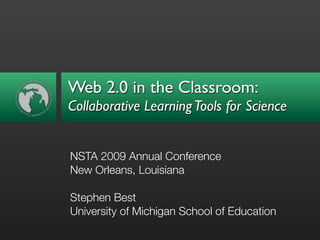
Nsta Web20 Science
- 1. Web 2.0 in the Classroom: Collaborative Learning Tools for Science NSTA 2009 Annual Conference New Orleans, Louisiana Stephen Best University of Michigan School of Education
- 2. Objectives
- 3. Objectives • Review the common practices of science and see possible online collaborative tools to support these practices
- 4. Objectives • Review the common practices of science and see possible online collaborative tools to support these practices • Discuss the considerations of using Web 2.0 tools to support science learning and instruction
- 5. Objectives • Review the common practices of science and see possible online collaborative tools to support these practices • Discuss the considerations of using Web 2.0 tools to support science learning and instruction • Review examples of applications of commonly used Web 2.0 tools for science instruction and learning
- 6. What do we ask kids to do to learn science?
- 7. What do we ask kids to do to learn science? take notes ■ have a discussion ■ do an experiment ■ read a map ■ make a graph ■ draw a picture ■ make a concept map ■ write an essay ■ make a table ■ view a demonstration ■ look up a definition ■ watch a video ■ solve a math problem ■ explain a concept ■ compare and contrast information ■ search for reference information ■ write a story ■ make a list ■ answer a question ■ look at pictures ■ read a book ■ create a web page ■ share information ■ take a picture ■ talk with a teacher ■ ask an expert ■ make a presentation ■ post a link ■ make a diagram ■ etc.
- 8. The Practices of Learning Science • Document creation / note-taking • Brainstorming / concept mapping • Drawing and diagramming • Data collection and analysis • Researching and reading text and information • Viewing images or video • Presentations and sharing information
- 9. Collaboration • For years, rarely a focus for instruction! (we often try to prevent collaboration) • A key component of the social constructivist approach to learning • Allows for higher level thinking and analysis on a level that previous activities did not • A critical skill for learners and scientists in the 21st century
- 10. Where to start? • Before you try finding tools, decide what the purpose of the use of these tools is going to be! • http://www.go2web20.net/ • Choose the tools that are likely to stick around for a while (i.e. they are backed by actual $) • Limit the number of tools you intend to use
- 11. Document Creation/Notes • Lots of possible tools that allow collaboration • Google Docs or other web-based “office” tools • Note taking applications that allow for easy searching and navigation (Evernote, Zoho, or similar) • Wikis can also be used for a large set of information and tracking of collaborative efforts
- 12. Brainstorming/ Concept Mapping • Depends on the goal and functionality of the tools • Generally better left to other means, but there are tools that allow for this • Webspiration, Spinscape, MindManager, and other tools for the web (similar to Inspiration)
- 13. Drawing & Diagramming Option 2: •Option 1: •Capture of your paper/ •Creation of online drawings, diagrams, and writing efforts or... designs •Note-taking or •Bamboo space and other document collection drawing and diagramming sites like Evernote sites •Picture capture sites •Allow multiple media and like Flickr multiple “artists”
- 14. Data Collection / Analysis • It all depends on the types of data... • Numerical data: online spreadsheets (Google Docs) • Instrument specific data: content site tools (i.e. Weather Underground) • Observation data: Text can use wikis and online documents (i.e. Google or Zoho Docs) • Image/Video data: Flickr and other image sites
- 15. Research and Reading Text • Google search (custom search engine tools) • iPaper or other document reading sites • Delicious, Digg, and other content review sites • More basic text tools (blogs, wikis, etc.) • Note taking tools that allow for web clipping
- 16. Viewing Images and Video • Common image and video viewing sites (Flickr, Photobucket, YouTube, Vimeo) • Content specific images and video (NASA, U.S. Geological Survey, etc.) • Participant submitted video (TestToob, TeacherTube, etc.)
- 17. Presentations and Sharing Information • Slide creation and presentation sites (280 slides, Google Presenter, etc.) • Slide sharing sites (Slideshare, etc.) • Video sites (slides exported as video- podcasts, downloadable/streaming video, etc.) • Online document sharing (Scribd iPaper or others)
- 18. Assessment • Does not depend on the tool • Use the collaboration features of any of the tools, and establish useful rubrics for collaborative assessment • More important to develop the guidelines and procedures for using any of the previously mentioned sites
- 19. For More Information • Handouts and slides available at: http://mmstlc.net • Slide shows, commentary, podcast, and other resources at: http://catalyst.mmstlc.net • Contact information at the MMSTLC Site listed above
